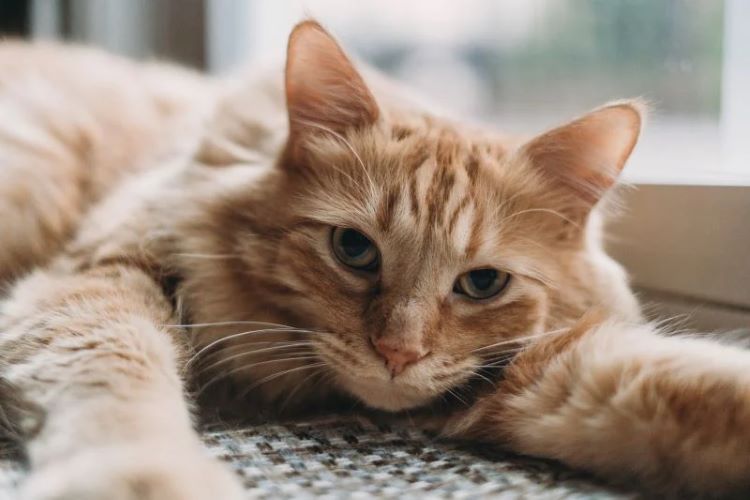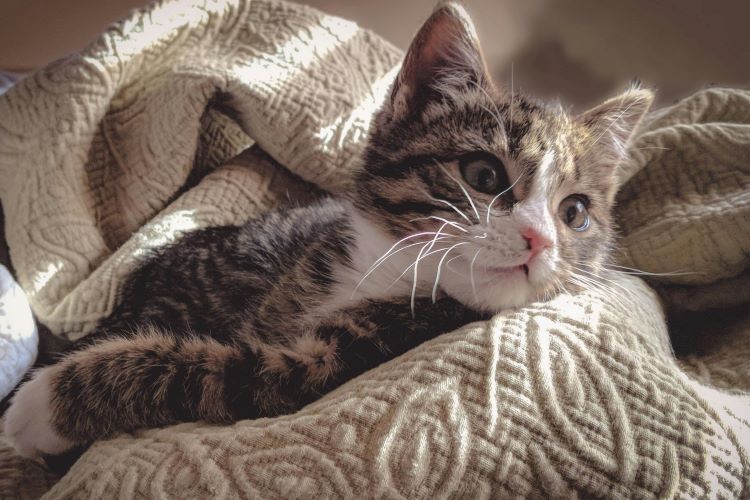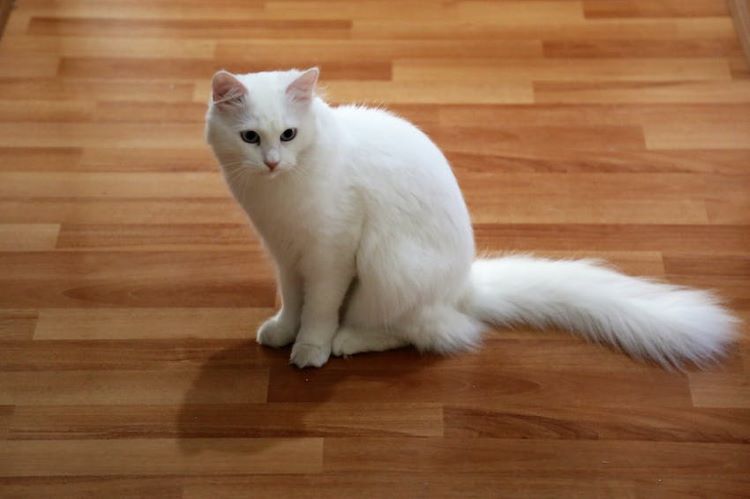Ready to help treat your pet to a healthy life?
What is a Domestic Medium Hair Cat?
By : Trupanion Staff | Updated Jul 25, 2024

You've probably heard of the Domestic Shorthair, but what about the Domestic Medium Hair? Also known as the "DMH" or "Semi-Longhair" is a type of cat with, as its name suggests, a medium-length coat and mixed breed ancestry. Though contrary to popular belief, they are not a specific cat breed of their own. Instead, they're a category of domestic cat defined by their fur length, which is longer than short-haired cats but shorter than long-haired breeds. DMH cats come in various colors, patterns, and personalities, inheriting diverse traits from their mixed lineage.
A (usually) cuddly and docile cat, the Domestic Medium Hair is often considered the perfect hybrid of his domestic short- and longer-haired relatives. They tend to be highly adaptable as well, with medium to low energy levels. Whether you're curious about cats, considering adopting a DMH or simply trying to learn more about your fluffy family member, we've put together this Domestic Medium Hair cat breed guide to help.
Defining the Domestic Medium Hair
Though not its own established cat breed, the Domestic Medium Hair nevertheless is said to possess certain traits defining its physical appearance and personality:
- Playful, affectionate, and friendly while still being independent
- Medium, muscular build
- Medium-length, double hair coat
- One- or two-colored, tabby, calico, tuxedo, or tortoiseshell
Because this cat has a mixed ancestry, its exact lineage is difficult to trace. As noted above, the result is a medium to large cat with a relatively muscular build and average height. Domestic Medium Hair cats generally weigh 10 to 16 pounds as adults, but the truth is their size can vary wildly. They tend have a slightly angular face that is softened by their fur; pointed, erect ears; large, alert eyes; and a long, feathery tail.
DMH cats have a unique double coat that is neither long nor short, but somewhere in between, giving them a fluffy, cuddly appearance. Some pet owners describe them as Teddy bear-like. They can be found in any number of colors, including single colors such as white, black, or orange, two-toned such as the tuxedo or orange and white, or multi-colored such as the calico, tortoiseshell, or tabby. Their eyes also vary in color, and come in shades of green, brown, hazel, or blue.
History and temperament
Unlike specific cat breeds developed through selective breeding for distinct traits, DMH cats emerged naturally from the gene pool of domestic cats, gaining their unique medium-length coats. In the late 19th and early 20th centuries, cat fanciers began to establish more formal breeds with standardized traits. At the same time, this resulted in cats being bred for longer fur and cuddly traits who did not end up belonging to any particular breed.
It's tough to say when the term "Domestic Medium Hair" was actually first used as a descriptor, but it has become more prevalent in recent years as greater distinction between these cats and other domestics is recognized (more on this below). In some countries like the UK, the term "Semi-Longhair" is more commonly used than Domestic Medium Hair. Though to add to the confusion, this is also sometimes used to refer to a long-haired version of the British Shorthair, which is considered its own cat breed rather than a categorization.
Today, DMH cats are recognized for their versatility, resilience, and diverse genetic heritage, reflecting centuries of adaptation and integration with human societies. Given their mixed breeding, Domestic Medium Hair cats are diverse in personality and temperament. Most of these cats are playful, friendly, and easy-going, while others are quieter, or more independent.
Early training and desensitization, including playing with their paws, ears, and face, can help kittens be more tolerant and affectionate adults, although this is not guaranteed.
What's the difference between Domestic Shorthair, Longhair and Medium Hair cats?
Great question! The only real difference between these types of cats is their fur length. The DMH is essentially the same kind of feline as the Domestic Shorthair and Domestic Longhair, just with hair that falls in between. Because of this, they may get miscategorized as one of these other types (especially the Longhair).
As kittens, these three cats can be even trickier to differentiate as fur tends to start out shorter for all. However, you can look for indicators like shorter overall coat but longer hair at the ears and around the paws.

Common health concerns
The Domestic Medium Hair cat is susceptible to many of the same health concerns as their domestic short- and long hair counterparts. Keep in mind that this doesn't guarantee your own DMH will get sick. All types of cats are simply more susceptible to certain health conditions over others, and it's important to be aware of their risks as a cat owner. The good news is that these cats tend to have a lot of genetic diversity, which means that they tend to be healthy cats overall and not prone to the hereditary disorders that established cat breeds are.
Some of the common ailments for the DMH include (but may not be limited to):
Obesity
If left to free feed, many Domestic Medium Hair cats will consume more food than they need and, combined with inadequate exercise, they can quickly become overweight and eventually obese. This is a common problem in today’s domestic feline species.
Obesity puts cats at risk for secondary diseases, such as diabetes mellitus, respiratory problems, and joint problems such as arthritis. If your cat is overweight or obese, seek veterinary care for a weight-loss plan.
To avoid obesity in your cat, consider portioning out his food every day, nixing treats, and ensuring daily activity.
Hyperthyroidism
Generally diagnosed in older cats, hyperthyroidism involves an overproduction of thyroid hormone, usually caused by a tumor on the thyroid gland that is often benign but occasionally can be cancerous.
Hyperthyroidism signs include weight loss, increased appetite or thirst, hyperactivity, increased vocalization, or an unkempt, matted, or greasy hair coat.
Chronic kidney disease (CKD)
A common ailment in many cat breeds, CKD is a degenerative disease that usually manifests later in life and is characterized by decreased kidney function over time, which can be months to years.
Clinical signs are not generally seen until kidney dysfunction reaches 67% to 70%, when signs can include increased drinking or urination, weight loss, vomiting, diarrhea, inappetence, or an unkempt coat.
Other health concerns
- Periodontal disease
- Gingivostomatitis
- Cancer, such as lymphosarcoma
- Inflammatory bowel disease
- Constipation
- Megacolon
- Arthritis
- Ear mites or infections
- Bladder stones
Thinking of adopting a Domestic Medium Hair cat into your own family? Make sure they’re protected and learn more about how cat insurance can help in the event of injury or illness.

Care tips for cat owners
Domestic Medium Hair cats are generally healthy, robust cats who aren’t too finicky or demanding, which makes them great choices as pets for first-time cat owners. Their easy-going attitude means they will likely get along well in larger families, including those with other cats or dogs. This is especially true for kittens.
Although their coats are not especially long, Domestic Medium Hair cats require regular brushing, at least weekly. Ideally, their teeth should be brushed at least three times per week and their nails clipped every few weeks.
Like all cats, Domestic Medium Hair cats are safest if kept indoors, but owners of indoor cats must enrich their cat’s indoor environment to prevent boredom, weight gain, and behavioral problems from developing. Scratching posts, elevated perches, interactive toys, pheromone products, and indoor “hunting” feeders will help keep your indoor Domestic Medium Hair cat physically and mentally stimulated.
Should you get a Domestic Medium Hair cat?
The Domestic Medium Hair cat may be the perfect cat for you if you:
- Are a first-time cat owner
- Have a family with children, or other cats or dogs
- Are willing to devote time and effort to grooming
- Live in a small apartment or a large house
- Are looking for a playful, affectionate, long-term companion
